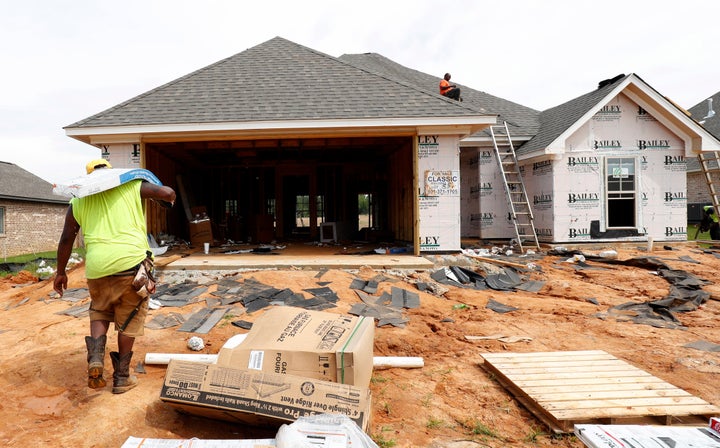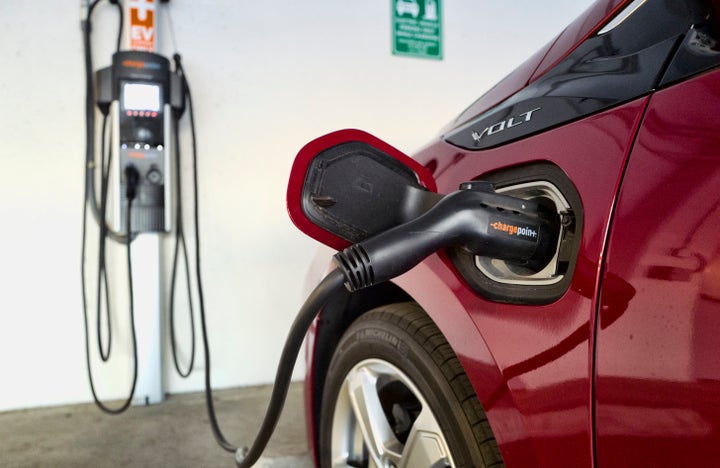
After failing to overturn an election expected to hasten the transition away from fossil fuels, conservative industry groups last year managed to get future votes canceled and tightened their grip over the process used to develop new building codes.
The Biden administration protested, along with dozens of major cities, but the battle over a critical tool for shrinking the fourth-largest source of the United States’ climate-changing emissions got little attention.
Now, fresh drama is afoot as the International Code Council writes the next set of codes, after a single email secretly sent by a gas utility nearly gutted a proposal widely seen as vital to increasing the adoption of electric vehicles.
Last March, the private consortium of industry associations and municipal governments that crafts the generic codes adopted in all 50 states revoked local officials’ long-held right to vote on the final version of energy-related codes, replacing the election with a technocratic committee that gives companies equal say to public servants. Yet the ICC, as it is known, said the new process would make it easier for the highly technical building specifications to take bigger leaps toward decarbonizing the nation’s homes, stores and office towers.
Instead, advocates now fear the latest incident illustrates how polluters enjoy even more control in a process over which they already wielded influence.
The issue erupted on Feb. 9 in an email chain among members of the committee charged with authoring the energy codes for commercial buildings, one of two such panels formed as part of the procedure that replaced the old government voting system.
After weeks of discussion over a proposal to require developers to include the circuitry to charge electric vehicles in more new buildings ― which can cost more than six times more to retrofit into a structure after it’s built ― the chairman of the committee, Duane Jonlin, abruptly announced in an email that he had decided to strike the proposal from the code. Instead, he said it belonged in the “appendix” that serves as a bonus menu that some more ambitious cities and towns may choose to adopt, according to copies of the exchange HuffPost obtained from a source who requested anonymity because the internal emails were private.
More emails HuffPost obtained via a public records request reveal what triggered the hasty shift: Spire Energy, the $3.5 billion St. Louis-based gas company, privately reached out to challenge the electric vehicle provisions.
Hours before Jonlin yanked the proposal, Thomas Schultz, a technical services analyst at Spire, emailed a consultant named Shaunna Mozingo to complain that the electric vehicle measure did not belong in the code. She, in turn, forwarded the email to Jonlin, who also serves as an energy code adviser to the city of Seattle. By that afternoon, Jonlin told committee members he had “made an executive decision” to remove the electric vehicle requirements from the code.
In an interview last week, Jonlin told HuffPost he now planned to reverse that decision. But it’s still early in the process of writing the codes set to debut in 2024, and advocates say the about-face came with no guarantees that the electric vehicle policy won’t be nixed again in the months to come. Reached by phone, Schultz declined to comment. Mozingo confirmed in a voicemail that she sent the email.
The incident ― wonky and soporific as it may seem ― highlights serious challenges for the nation’s energy codes at a moment when Americans struggle to afford rising utility bills and scientists warn that anything short of a revolutionary overhaul of energy systems threatens climate catastrophe.

In its latest assessment of the world’s best peer-reviewed research, the United Nations’ climate science panel on Monday found global warming was happening with greater speed and intensity than previously understood, but singled out new housing construction as an “opportunity” to respond at scale to the crisis. Meanwhile, each new building constructed to older, less climate-friendly standards adds more carbon to the atmosphere and increases the total cost of decarbonization, since those structures will eventually need retrofits that cost far more to add later.
And even with nearly 500,000 electric vehicles sold in the U.S. last year, the Biden administration has struggled to marshal the federal funding to provide the charging infrastructure required to make battery-powered cars competitive with incumbent models that benefit from the nation’s nearly 117,000 gas stations.
“The new process gives outside power to the gas utility industry, which has a vested interest in the indefinite sales of fossil fuels,” said Charlie Spatz, a researcher with the watchdog group Energy and Policy Institute who filed the public records request for Jonlin’s emails. “The gutting of the energy code-making process has provided the fossil fuel industry with an even larger megaphone, leaving committee chairs in a challenging situation.”
Revoking The Right To Vote
Tailpipes and smokestacks have long served as the symbols of climate destruction, and with good reason: Traditional cars, gas- and coal-fired power plants, and factories are, in that order, the three largest sources of carbon emissions in the U.S., comprising 77% of the country’s output in 2019, according to the Environmental Protection Agency. In fourth-place are homes and businesses, whose gas stovetops, oil furnaces and other fossil-fueled appliances comprise another 13%. But those are just greenhouse gases specific to buildings; counting the portion of power plant pollution from buildings’ energy use brings that figure up to nearly 40%.
The United States’ sheer size and its federalized system of government severely limit the power cities and towns wield over the nation’s auto fleet, electricity system and manufacturing sector. But mayors, city councils and county officials hold tremendous sway over what kinds of houses, apartments, offices and storefronts developers can build within their jurisdictions. So when cities and towns pledge to slash their climate-changing emissions to reduce local air pollution and do their part to keep global warming from exceeding a catastrophic 1.5 degrees Celsius, or 2.7 degrees Fahrenheit above pre-industrial averages, buildings are some of the few pollution sources they can meaningfully reduce.
Building codes are incredibly complex and technical, and few municipalities have the resources to write their own. Likewise, the building industry, from contractors to material manufacturers, needs some uniformity in standards. Enter the ICC, which every three years updates a generic set of building codes that every state and some countries in Latin America and the Caribbean legally recognize as the standard.
For years, the ICC convened industry groups, governments and environmentalists to hash out what should be in the latest version of the code. Then the government bureaucrats charged with enforcing the codes would vote on the final version. In 2019, however, the normally sleepy process was jolted when droves of U.S. cities ― frustrated by the paltry efficiency gains over the last few code cycles ― organized to vote in favor of measures to drastically ramp up the version of the energy code that took effect last year. It was an overwhelming success. The 2018 code improved efficiency by barely 1%. By contrast, the 2021 code they approved the next year increased efficiency by up to 14%, promising reductions of as much as 50 million metric tons of carbon dioxide per year by 2030, equal to shutting down 47 coal-fired power plants.
Industry groups immediately cried foul. The National Association of Home Builders and the Leading Builders of America, which had long held power over the ICC behind closed doors, challenged the legitimacy of the election, claiming that many of the government officials who cast ballots were ineligible to vote. The protest failed.

But the American Gas Association, a trade group for natural gas utilities, appealed five of the provisions that voters had overwhelmingly approved. The ICC’s three-member appeals board overturned all five, including ones making it easier and cheaper for homeowners to use electric water heaters and electric vehicles. Of more than two dozen appeals filed by industry groups in total, those were the only ones granted.
The ICC, in a move that puzzled many longtime observers, then proposed ending all future elections and switching to a committee-consensus model that gives governments and industry equal representation. The consortium said more than two-thirds of jurisdictions were operating under old versions of the code, so creating a more balanced approach was key to increasing adoption of the latest mandates.
Yet the change drew fierce protest from local governments, environmentalists and architects. The Biden administration’s Department of Energy warned the ICC that ending voting would “be detrimental to an appropriate process with appropriate transparency” and stunt “important economic and environmental benefits at the local level.”
Unfazed, the ICC announced the change in March 2021 anyway. The American Public Gas Association, another trade group representing gas utilities, told its board of directors the new system “should be beneficial,” according to an internal document HuffPost first published last year.
Fears Mounting And Time Running Out
It took the ICC four months to appoint members to the two committees writing the 2024 energy codes for commercial and residential buildings, which it is expected to finalize next spring. The consortium still has yet to name anyone to an independent third committee that is supposed to help dictate the speed at which codes slash carbon emissions.
That separate body, which the ICC said will be constituted by early summer, is critical. When the ICC appeals board gutted some of the 2021 code’s biggest climate measures at gas utilities’ behest, it justified the decision by stating that the energy code could only include provisions that saved energy, such as insulation or modern light fixtures. Parts of the code that served primarily to aid the energy transition, by contrast, belonged in the appendix, where some cities and states could choose to adopt or ignore provisions seen as more political in a country where many still dismiss the reality of climate science.
But 60% of states don’t allow cities and towns to adopt codes that differ from those used statewide, meaning the appendices are only available to a small fraction of U.S. municipalities.
Squeezed for time and worried it would just be removed from the code at a later point, Jonlin ― a liberal longtime advocate of cutting emissions, who had opposed eliminating the government vote ― said he turned down the electric vehicle proposal out of fear that industry would successfully contest it anyway.
“My big concern is that we not waste time,” he said by phone. “I want to make sure we don’t get to the end of the process and then have a challenge that then overrules us and then we have to do it over. That’s my big motivator: to make sure we’re doing it right the first time given the extremely limited time.”
But the decision riled the committee, which ― lacking the as-yet-unnamed climate panel to refer to ― asked the ICC staff for advice. An ICC employee last week delivered a surprise verdict, telling the committee in a memo that the electric vehicle proposal could, in his opinion, be part of the code.
“I’m going to reverse course,” Jonlin said. “We can have it the way it was originally.”
“The gutting of the energy code-making process has provided the fossil fuel industry with an even larger megaphone, leaving committee chairs in a challenging situation.”
- Charlie Spatz, researcher at the Energy and Policy Institute
Ryan Colker, a vice president at the ICC, said the incident illustrates that the new, bureaucratic way of writing the energy codes is working.
“In this case, the new consensus process actually did what it was supposed to do,” he said by phone. “It brought light to an objection from someone, which then resulted in conversations within the committee and a resolution that ultimately allowed the committee to continue its deliberation and decide the best approach moving forward.”
But the issue isn’t resolved, said Kim Cheslak, the director of codes at the New Buildings Institute and a member of the commercial committee. Jonlin put the electric vehicle proposal back into the code on the advice of an ICC staffer who does not speak on behalf of the all-powerful appeals board, which struck down similar policies during the last code cycle. She fears that could easily happen again.
“It’s just one staffer’s opinion,” she said. “It’s not worth the paper it’s written on if the board can just overturn it anyway.”
The two committees are currently reviewing 450 separate proposals, with plans to complete drafts of the codes by this June. Later this summer, the ICC will make the proposed codes available for public comment. The entire process aims to wrap up by the start of summer 2023.

